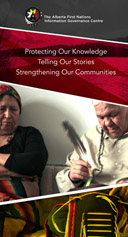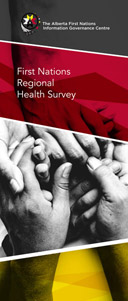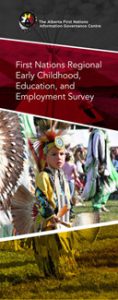
Did you know?
Over 80% of youth had a positive self-image and either strongly agreed or agreed that they liked the way they were; that they had a lot to be proud of; that a lot of things about them were good; and that they were doing things well!
Some of our event banners!



Frequently Asked Questions
01. What is the purpose of AFNIGC?
Alberta First Nations will now have a dedicated Centre that will serve as the permanent home of the Alberta’s First Nations Regional Health Survey (RHS) and the First Nations Education, Employment and Early Childhood Education Survey (FNREEES) on-reserve and in northern First Nations communities. This survey, commonly referred to as the “REEES”, will begin data collection in the fall of 2013.
The Alberta First Nations Information Governance Centre (AFNIGC) will provide an abundance of information, training, data collection, analysis and dissemination services to Alberta First Nations in Treaty No. 6, Treaty No. 7 and Treaty No. 8. In addition, the Centre will also support in the development of community information management strategies that will serve First Nations research needs as determined by each community and Treaty Area.
02. Is AFNIGC supported by First Nation leadership?
At the Assembly of Treaty Chiefs held on January 26 & 27, 2010 in Alberta, Resolution 27-01-2010/#002 R was passed in support of the development of the Alberta First Nations Information Governance Centre (AFNIGC). AFNIGC is a satellite office of the First Nations Information Governance Centre (FNIGC) in Ottawa and is the representative body for the Alberta region.
03. Why is the word governance used in your Centre´s title?
The development of the Regional Health Survey (RHS) process has changed how research is currently conducted in First Nation communities in Canada. The RHS puts First Nations right to self- determination into practice in the area of research and information management by helping First Nations govern how community data is collected and used by outside bodies. The information collected by the RHS is for First Nation leadership to showcase the realities of First Nation communities in order to make policy changes and positive changes within the community.
04. What is the AFNIGC mandate for partnerships?
The Centre has a clear mandate to use research and information collected from the First Nation communities in manners that will truly benefit the health and well being of First Nations. It strives to partner with entities that seek mutually beneficial relationships with First Nations through processes that respect First Nation jurisdiction over research and data and to own, protect, and control how their information is collected, used and disclosed.
05. Is AFNIGC subject to Federal and Provincial privacy laws?
Federal and Provincial legislation are only applicable to government organizations. There is no Federal or Provincial legislation that acknowledges or protects community level privacy. While Alberta First Nations Information Governance Centre (AFNIGC) is not a government organization, we follow the First Nations Principles of Ownership, Control, Access, and Possession (OCAP®) and in doing so take protecting the privacy of individuals and communities to a higher level of protection.
06. Does the AFNIGC develop privacy policies for First Nations?
Alberta First Nations Information Governance Centre (AFNIGC) has developed privacy templates with the guidance and assistance of the First Nations Information Governance Centre (FNIGC) legal counsel, which are available for communities to review and use in the development of their own privacy policies unique to their Nation.
07. Who funds the AFNIGC?
Alberta First Nations Information Governance Centre (AFNIGC) receives funding from the First Nations Information Governance Centre (FNIGC) in Ottawa; we have also entered into a contribution agreement with Health Canada´s Alberta Region First Nations and Inuit Health (FNIH).
08. Who is AFNIGC accountable to?
Members of the Alberta First Nations Information Governance Centre (AFNIGC) are duly elected Chiefs of Alberta residing at the Alberta Assembly of Treaty Chiefs. It is through the membership of AFNIGC that the organization is accountable to the First Nations of Treaty No.6, Treaty No.7, and Treaty No. 8.
09. How is the AFNIGC Board of Directors and Chiefs Senate chosen?
The Alberta First Nations Information Governance Centre (AFNIGC) Board of Directors and Chiefs Senate are chosen through Treaty area processes and appointed by the Treaty Area Grand Chief.
10. How does AFNIGC differ from other organizations invested in First Nations research?
Alberta First Nations Information Governance Centre (AFNIGC) is 100 per cent accountable to leadership and the First Nation communities it serves. Our research efforts are focused strictly on First Nations living on reserve as well promoting self-determination in the area of research and information management. We guarantee the safe keeping of community data and protect the identities of all participants resulting in harm reduction of First Nations.
11. What is the RHS?
The Regional Health Survey (RHS) is the foremost national First Nations survey. The First Nations Information Governance Centre (FNIGC) and its regional partners are producing innovative approaches in data sharing, research ethics, computer-assisted interviewing, sampling, field methods and training, including culturally appropriate questionnaire content. Most significantly, the RHS process has helped enhance research relationships First Nations have with researchers and institutions by building capacity in First Nations information management. Community participation in all aspects of design, collection and analysis continues to ensure that data is relevant and the governance and accountability mechanisms are appropriate. RHS collects data every 4 years and to date has completed two survey cycles – RHS Phase 1 (2002-03) and RHS Phase 2 (2008-2010).
12. What is OCAP®?
Recognizing the historical harm resulting from research in First Nations communities and First Nations assertions of governance over community information, the First Nations Information Governance Centre (FNIGC) developed the FNIGC Code of Research Ethics which contains First Nations Principles of Ownership, Control, Access and Possession (OCAP®) with respect to our data, information, and traditional knowledge.
OCAP® is based on self-determination as a fundamental right of First Nation peoples as acknowledged in international law and by Section 35 of the Canadian constitution. First Nations are actively taking steps to implement this right. The Government of Canada has a duty to protect First Nation rights and title to a clear and acceptable standard as set out in the minimum standards defined by the United Nations Declaration on the Rights of Indigenous Peoples. Canada´s duty to consult and accommodate First Nations is an integral component of acknowledging and protecting the right to self-determination.
13. How can First Nations apply OCAP® principles?
First Nations are asserting their inherent right to self-determination by implementing Ownership, Control, Access, and Possession (OCAP®) principles in all data sets residing in their communities;
The Alberta Assembly of Treaty Chiefs adopted a research mandate by passing the OCAP® Resolution 30-03-2010#03R;
To implement OCAP, Alberta First Nation leadership assert their inherent right to self-determination by exercising control over their data and clearly asserting jurisdiction over reliable research and accurate statistics which are based on First Nations principles of OCAP®
The Alberta Assembly of Treaty Chiefs (AoTC) continue to assert self-determination and OCAP® principles, thereby ensuring any research conducted in their communities be OCAP® compliant;
AoTC are continually establishing privacy policies as a mechanism of protecting both individual and community level privacy; and
Chiefs are stewards of their community´s data and require free prior and informed consent before sharing information. Leadership must be involved in every stage of research involving Alberta First Nation communities which reflect First Nation research ethics, values and accountability to Alberta First Nations Leadership in Treaty No. 6, Treaty No. 7 and Treaty No. 8 (Alberta).
14. What training opportunities are available through the AFNIGC?
The Alberta First Nation Information Governance Centre (AFNIGC) conducts regular training sessions with field workers at the time of data collection initiatives in communities. Ownership, Control, Access, and Possession (OCAP®) training sessions are currently being developed to better inform community members about privacy practices, data sharing agreements and license to use agreements.
15. How are First Nation communities selected for the RHS survey?
Alberta First Nation communities are randomly selected based on a sampling framework designed by the First Nations Information Governance Centre (FNIGC). Representatives from the Alberta First Nations Information Governance Centre (AFNIGC) approach selected communities and negotiate the research relationship, involving community from beginning to the end. First Nation individuals residing in the selected communities are randomly selected using updated band membership lists.
16. How does the AFNIGC plan to protect RHS data?
The First Nations Information Governance Centre (FNIGC) and Alberta First Nations Information Governance Centre (AFNIGC) operate as data stewards committed to the protection of data guided by strict privacy protocols as well as the FNIGC Code of Research Ethics. Currently the data collected from RHS Phase 2 (2008/10) is stored at the FNIGC, and soon to be stored at the offices of the First Nations Alberta Technical Services Advisory Group (TSAG) following the same strict protocols. The Alexander Data Centre has also been appointed as the backup server for data secured by AFNIGC.
